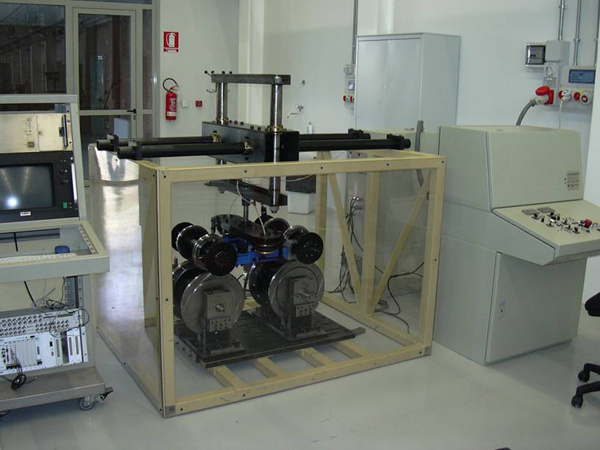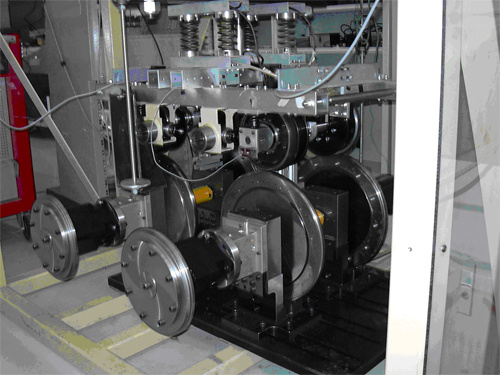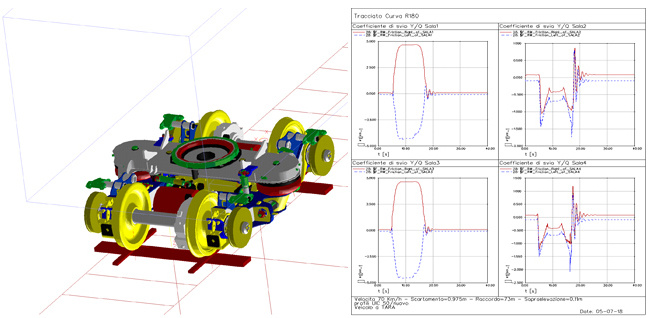Research topics (Railway vehicles)
Numerical simulation of dynamic stability in railway vehicles
The research topic on the numerical simulation of railway vehicles running on the track has been referred to different kinds of passenger vehicles both at high velocity and provided with tilting devices or self-steering mechanisms.
The group has begun such activity on 1996 thanks to the cooperation with MDI-Italia, which concretized in an intense collaboration activity during the development of the first versions of the Adams/Rail code.
Research activity in field of passenger vehicles was also supported by the collaboration with Fiat-Ferroviaria, whose vehicles ETR450, ETR460, Pendolino Finlandia, were the base for various research theses.
The investigation fields concern principally running safety (derailment, stability) but also the interaction between vehicles (long trains) and transitory conditions (traction/brake).
This research line concerned and concerns also the study of boxcars, characterized by constructive solutions and requirements very different from that of passenger vehicles, that necessarily must share the same lines of passenger vehicles. During the analysis of the vehicle running simulations, the following objectives were taken into account:
- Increase of the axle load (and payload)
- Increase of velocity
- Reduction of the impact on the infrastructure (wear of the rail)
The research group developed, in collaboration with the University of Rome "Tor Vergata" and the company SAB-WABCO (now Faiveley transport), a project addressed to the study of the dynamic behaviour of long freight trains.
This subject has fundamental importance in the study of the braking problems and in the evaluation of improvements to the safety system in terms of efficiency and safety, derived from the design of braking systems and from structural limitations of coupling systems and of the buffers/hook.
Within the project it has been realized a simplified simulation module for vehicle dynamic, this works in real time and is interfaced with a real braking system of a long train. In this way, it is possible to evaluate of the influence of the braking on the vehicle dynamics and longitudinal stress during braking, both during straight running and curving, also in presence of track inclinations.
Separately some elements with non-linear behaviour of the bogie were analysed and characterized, through dynamic identification. Specifically it was accurately analyzed the study of the behaviour of anti-yaw dampers, both in their most common version for passenger vehicles (hydraulic), than for friction dampers, used for freight transport.

Figure 1: Test-bench with narrow gauge bogie for light transportation (scale 1:4).
Stability tests on scaled prototypes of railway vehicles on roller test bench (Roller-Rig)
At the Railway technology laboratory a Roller-Rig has been realized which is a dynamic track simulator developed to carry on tests on prototypes of railway vehicles in reduced scale. The roller rig has been designed using a modular approach, and is composed by 4 independent rollers, with the possibility of changing the wheelset spacing (1.8 – 3.5 m in scale 1:5, 1.45-2.8 m in scale 1:4), the gauge and the roller profiles.
The roller-rig is completed by a modular bogie realized for the normal gauge, with the possibility of changing the wheelset spacing (1.8-3.5 m scaled), the characteristics of the primary suspensions independently for the three directions, the wheel profiles and the axle-load. The bogie can be employed to perform parametric tests or optimization tests by varying the vehicle characteristics.
The roller-rig can be used to run stability tests, traction/braking, slant test and comfort analysis.
Experimental tests allow, since the first design phases, and with great advantages on the result of the entire design, to validate numerical models of vehicles realized through Multibody codes (Adams / Simpack) or ad hoc realized codes (e.g. Matlab / Simulink environment). Numerical simulation to achieve reliable results always requires the experimental validation of the models.
This procedure was applied in the project of a narrow gauge (950 mm prototype represented in figure 1) with bogie using side flexible chassis and air springs for vertical suspensions, inside the DIADI project of the Regione Piemonte.

Figure 2: Roller Rig with modular bogie and braking devices installed.
Study of sensors and diagnostic systems for diagnostic of the vehicle
This research topic, strictly connected to the previous activity, considers the development of diagnostic techniques and of innovative sensors to be applied to railway vehicles in order to improve running safety, through preventive maintenance of possible failures. The sensors must allow the detection in real time of anomalous events (derailment, instability) and to control the wear and damage conditions of the principal components of the bogie (braking system, bearings, suspensions, profiles), allowing a timely programming of the maintenance interventions.
In the study of the monitoring of the railway dynamics the characterization of the fundamental parameters to measure for the preventive maintenance and safety can be supported by the roller rig as test bench, this reveals useful for the type of sensors to use and for their positioning.
Wireless sensors networks are particularly interesting because they do not need alimentation and cable connections; they can thus be collocated on moving organs (wheelset, bearings, bogie) or that cannot be easily reached by connecting cables. This kind of sensors was realized through the MEMS technology, which is today employed mainly in the safety devices (ex. airbag) in the automotive field.
The development of these sensors is supported by the employ of the test-bench roller rig, where it is possible to reproduce in a repeatable and safe way different kinds of anomalies and running conditions of the vehicle.
These projects activities are synthesized by the following tasks:
- Identification and analysis of the bogie anomalies and of the vehicle conditions.
- Definition, through numerical simulation and experimental preliminary tests, of a set of fundamental parameters to be measured for the preventive maintenance.
- Definition and acquisition of sensors to detect the parameters cited at point b).
- Definition and development of algorithms for the determination alarm signals and requests of maintenance interventions based on the detected signals and of the critical parameters.
- Realization of a prototype of the system and experimental testing conducted on Roller-Rig.
- stability
- damage of the axle
- anomalous wear of the profiles
- temperature of the bearings
- disposition of the load
- braking (disk brakes).
Development of algorithms and simulation codes of the wheel-rail and wheel/roller contact and of the wheel and rail profiles wear.
This research line concerns the analysis of the forces developed at the contact between wheel and rail during vehicle running on straight or curved tracks, in order to evaluate the vehicle stability, and to analyse the wear evolution on the wheel and rail profiles.
In the research activity, the rolling contact simulation was analysed by a mathematic point of view, also considering the problem of the simulation of the double contact during curving. The activity has been developed in collaboration with the TU-Delft, with the contribution of Prof. Meijers and De Pater, by formalizing a new methodology for the theoretical calculation of the contact forces in presence of double point contact in curve.
Various models of wheel-rail and wheel-roller contact were successively developed, at first in Matlab environment and then implementing them in commercial multibody codes.
The ongoing activities concern the improvement of contact modules, the calculation of adhesion forces at the contact in different friction conditions and the study of profiles wear. On this purpose, an experimental device to be applied to the roller rig is being designed; this will allow the measure of the adhesion forces and the validation of the numerical model.

Figure 3: Multibody model of a railway vehicle (Simpack code) and example of numerical results during curving (right).
Study of sensors and diagnostic systems for diagnostic of the vehicle
This research topic, strictly connected to the previous activity, considers the development of diagnostic techniques and of innovative sensors to be applied to railway vehicles in order to improve running safety, through preventive maintenance of possible failures. The sensors must allow the detection in real time of anomalous events (derailment, instability) and to control the wear and damage conditions of the principal components of the bogie (braking system, bearings, suspensions, profiles), allowing a timely programming of the maintenance interventions.
In the study of the monitoring of the railway dynamics the characterization of the fundamental parameters to measure for the preventive maintenance and safety can be supported by the roller rig as test bench, this reveals useful for the type of sensors to use and for their positioning.
Wireless sensors networks are particularly interesting because they do not need alimentation and cable connections; they can thus be collocated on moving organs (wheelset, bearings, bogie) or that cannot be easily reached by connecting cables. This kind of sensors was realized through the MEMS technology, which is today employed mainly in the safety devices (ex. airbag) in the automotive field.
The development of these sensors is supported by the employ of the test-bench roller rig, where it is possible to reproduce in a repeatable and safe way different kinds of anomalies and running conditions of the vehicle.
These projects activities are synthesized by the following tasks:
- Identification and analysis of the bogie anomalies and of the vehicle conditions.
- Definition, through numerical simulation and experimental preliminary tests, of a set of fundamental parameters to be measured for the preventive maintenance.
- Definition and acquisition of sensors to detect the parameters cited at point b).
- Definition and development of algorithms for the determination alarm signals and requests of maintenance interventions based on the detected signals and of the critical parameters.
- Realization of a prototype of the system and experimental testing conducted on Roller-Rig.
- stability
- damage of the axle
- anomalous wear of the profiles
- temperature of the bearings
- disposition of the load
- braking (disk brakes).
